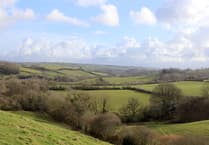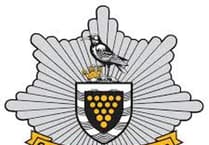BODMIN featured in a BBC1 show charting actress, broadcaster, comedian, presenter and writer Sue Perkins’ quest to explore her family history.
In Thursday, May 26’s Who Do You Think You Are? (repeated on Tuesday, May 31) we first saw Sue explaining how a hobby of competing in the boxing ring helps to give her a ‘sense of peace’, before she then joined her best friend and fellow former Bake Off presenter Mel Giedroyc in explaining why she wanted to learn more about her paternal grandparents’ and maternal great-grandparents’ story.
When it came to her paternal grandfather, Albert Perkins, and showing Mel a photograph of him in later life, she said that he had always seemed a rather stern and distant figure who had served as a soldier and there were family stories that he had “had bits blown off him in every major conflict”.
His wife Flo, by contrast, was known to have been a former midwife who radiated kindness. Mel immediately spotted that a photograph of the young Flo had been taken in Bodmin, and in a box of old photos provided by Sue’s mother, the duo also found a marriage certificate from August 24, 1917, when Albert Edward Perkins, aged 41, address The Barracks, had married Florence May Knowles, aged 22, a nurse, at St Mary’s Roman Catholic Church in the Cornish town.
Sue then travelled to Cornwall and footage showed her driving across a wintry and misty Bodmin Moor while stating that so far, to her, her grandfather Albert was “as bleak, remote and utterly unknowable” as the landscape around her.
When she met the first of the episode’s genealogists, Maggie Lewis, it was outside the church where her grandparents were married – but which Maggie revealed was now a luxury homes complex.
Further documents presented by Maggie revealed that Sue’s grandfather Albert had in fact been born in Axminster, East Devon, on December 19, 1875, to Henry Perkins, a railway signal fitter, and Fanny Perkins nee King but that his mother had died when he was only six months old on July 23, 1876. The 1881 census then showed that his father had then remarried a woman named Mary-Ann, which Sue saw as a hopeful development, as long as she had been a kind stepmother.
However, Maggie then revealed a progressively bleaker picture, with both stepmother and father dying from TB by the time Albert was six years old, and then both Albert and an elder brother named Sidney ending up in the grim and regimented environment of the Exeter Workhouse.
The records then showed that a relative from Frome in Somerset, Francis Perkins, had stepped in – though at first he had chosen the very date of Albert’s seventh birthday to apply to take only elder brother Sidney away into his care while leaving Albert alone in the workhouse. Fortunately, Francis redeemed himself around a year later by applying through a clergyman to take Albert too, but Sue was convinced that these early experiences must have been extremely traumatic for her grandfather as a boy.
The cameras then moved to Bodmin Keep - Cornwall’s Military Museum, where military historian Andy Robertshaw revealed to Sue attestation papers dated March 6, 1892, showing that at the age of 17 (though passing as age 18), Albert had joined the Duke of Cornwall Light Infantry for a term of 12 years, perhaps gaining a sense of ‘family’ from the Army that he had so far failed to find in childhood.
The records revealed that Albert had only been 5ft 5in tall – to a degree bearing out a joke Sue said her father had used to tell about Albert only surviving the conflicts he had served in due to the bombs and bullets going over his head.
Albert’s military service took him to India in 1897-98, then to guarding prisoners from the Boer War - not in South Africa but surprisingly in Ceylon (now Sri Lanka) - before leaving the service. But he then joined up again, when he need not have done, at the age of 40 in August 1914 – destined not to endure the horrors of the First World War battlefields in France or Flanders but the freezing winter mountains of Salonika, Greece.
After only a few months he was discharged and sent home due to contracting trench foot - but this led to him meeting, in hospital at Bulford Camp in Wiltshire, nurse Florence, who he went on to marry in Bodmin.
It transpired that far from being a cold and distant figure, Sue’s grandfather later took the unusual step for those time of looking after their children while his wife undertook the studies and training needed to become one of the first of a new generation of medically trained midwives, a path she followed for many years.
However, Sue said that she knew her grandparents had been quite poor in their later years, and she said she felt ashamed she hadn’t asked Flo more about their past when her grandmother had still been alive.
Sue then went on to explore the story of great grandparents on the maternal side of her family, Emil and Anna Muller, who she vaguely knew were German immigrants but whose story then took her through the mob violence in London that followed the U-boat sinking of the liner RMS Lusitania off the Old Head of Kinsale in Co Cork, Ireland, in 1915. Sue was then told about the Knockaloe internment camp set up by the British authorities during the First World War for UK residents of German, Austrian and Italian background on the Isle of Man, a place to which Emil was sent as a prisoner, leaving Anna having to fend for herself until his release at the end of the war.
It was then that Sue found that her joke about hoping to find her ancestors had come from Lithuania, like friend Mel’s, came true: they had in fact been German settlers who had moved to the eastern Baltic states. They had once owned a grand estate of which nothing now remains but had then returned to the ‘fatherland’ of Hitler’s Germany in 1940, only to be subjected to Nazi pseudo scientific tests to determine their ethnic origin and having a disabled child taken away from them. Returning to Lithuania after the war, they then suffered imprisonment with forced labour under the Stalinist regime.
Throughout these experiences, these relatives had remained German Lutherans and when Sue learnt that the former church they had attended in Lithuania was still standing, she wanted to see it. She was stunned to find that, remarkably, the building was now home to a boxing ring! It was an amazing outcome that ‘blew her mind’ and brought the episode almost full circle.
Who Do You Think You Are? can be viewed now on BBC iPlayer.




